

Colouring the World with Japanese Stationery
|
Stationeries are essentials that permeate every stage of our lives. From childhood to adulthood, stationeries fulfil the changing needs we have as we grow: children, with their unsteady hands, learn to write and draw with bright crayons; students go through countless numbers of writing and mathematical instruments in school; and adults, depending on their workplace, use a wide variety of pens, papers, stamps, and files to do their work.
As these are items that are used daily, many look for tools that work well and look good. From work to play, Japanese stationery manufacturers have always made high quality products that are affordable. It is no wonder then that their products are a mainstay in the stationery drawers of many worldwide. Many may be familiar with the Japanese pen manufacturing company Pilot Corporation. When the company was first established a century ago, it primarily made elegant maki-e (decorated lacquer) fountain pens. Incidentally, Pilot Corporation held an exhibition at JCC in 2014 to showcase the beauty of their maki-e pens in Singapore too. Over time, they developed new technologies that they incorporated into their pen designs. For example, in the 1970s, they launched the world’s first multifunctional writing instrument; this multi-pen combined black and red ballpoint pens and a mechanical pencil into one body, making it a convenient and useful staple in most pencil cases even till today. Newer designs even let customers choose their preferred colours, allowing them to customise their pens even further. They launched another innovative writing implement in 2006; the FriXion Ball ballpoint pen had ink that was erasable when rubbed. At first, it was only sold in Europe, but the novel idea was so popular that it was quickly launched in Japan, and later, all over the world. Since the invention of this erasable ballpoint pen, other implements such as erasable highlighters and coloured pencils have also been launched. By incorporating new technology and constantly developing new designs, Pilot Corporation and other Japanese pen manufacturers have also created writing instruments that fulfil a wide range of consumers’needs. Now, there are pens that are more ergonomic and allow for a more comfortable grip, as well as pens that can dispense a variety of ink types finely and smoothly. |
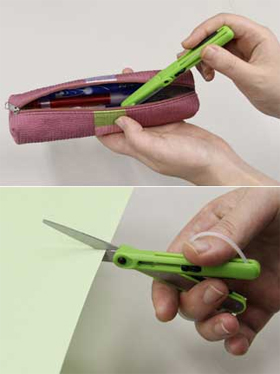 © Web Japan 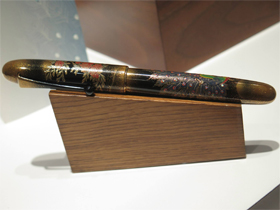 © JCC 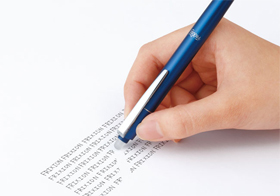 © PILOT Corporation |
|
Responding to concerns about personal privacy, Japanese companies developed a type of stamp called the keshipon. This rolling stamp can be used to black out sensitive information like names and addresses on envelopes and packages before they are thrown out. Newer models of this stamp even have ink that can remain even on glossy paper or material that repels ink. This makes the stamp a safer choice for hiding personal information than typical ink pens.
Japanese companies have also improved on tools such as the stapleless stapler. Instead of metal staple bullets, the stapleless stapler makes two cuts – one cut forms a slit, and the other creates a spade-shaped tab. It then pushes the tab into the slit, thereby hooking the sheets of paper together. When it was first developed in the early 2000s, it failed to make a splash; they required more effort to operate compared to traditional staplers, and could only handle a few sheets of paper at a time. In 2009, Japanese office supply giant KOKUYO launched their brand of stapleless staplers with improved blades capable of stapling 10 sheets at a time. Affordably priced, these staplers soon came into wide use, effectively reducing the need for metal staple bullets. Besides functional tools, many Japanese manufacturers also make stationery that can be used to decorate or make crafts. One example that enjoys worldwide popularity is washi tape. Pliable and made with an adhesive that is strong yet gentle on surfaces, it was used in industries to prevent surfaces from getting dirty. Craft enthusiasts all over the world saw the decorative potential in washi tape; the tape was used to decorate scrapbooks and gift-boxes, and even to put a unique spin on household items like light switches, bottles, and furniture. This newfound use spearheaded the production of washi tape emblazoned with various patterns. Because of its translucency, users can also layer various patterns of washi tape to create interesting effects with the patterns they have. The gentle adhesive means that the tape can be removed easily from surfaces, allowing users to redecorate their items as many times as they like! The freedom of expression that washi tape encourages is no doubt one reason why this Japanese product has seen an explosion in popularity worldwide. Besides the tools mentioned, there are still a wide plethora of products made by Japanese manufacturers that can be used not only for a range of activities. Whether you are looking for a multipurpose writing instrument for business and academia, or for vibrant tools to aid you in your creative pursuits, there is sure to be a Japanese stationery product that can fit your needs. |
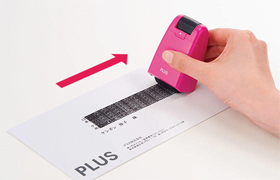 © PLUS Corporation 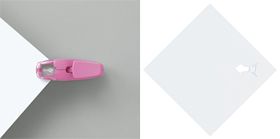 © Kokuyo S&T Co., Ltd. 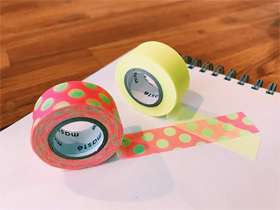 © Web Japan 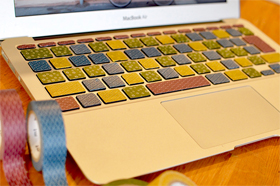 © Web Japan 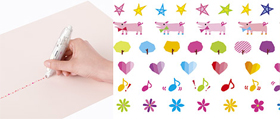 © PLUS Corporation |
Resources
|
Japanese Stationery. (2016, April 6). Retrieved July 16, 2020, from https://www.nippon.com/en/features/jg00094/ |
|
Japan Creative Centre 4 Nassim Road, Singapore 258372 +65 6737 0434 / jcc@sn.mofa.go.jp https://www.sg.emb-japan.go.jp/JCC/ Nearest parking at Orchard Hotel & Delphi Orchard |
 |